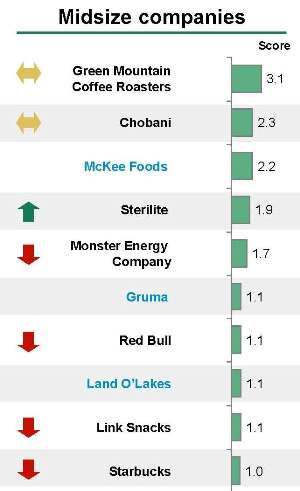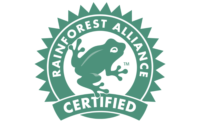Study: Hershey fastest growing large CPG company
Five confectionery and snack manufacturers ranked among fastest growing CPG lists created by Boston Consulting Group and IRI.

A new study ranking consumer packaged goods companies lists a confectionery manufacturer as the fastest growing large company and a snack bar maker as the fastest growing small company.
The Hershey Co. was ranked as the fastest growing large CPG company (more than $5 billion in retail sales) while Kind was ranked as the fastest growing small CPG company (less than $1 billion in retail sales). The fastest growing mid-sized company ($1 billion to $5 billion in retail sales) was Green Mountain Coffee Roasters.
As for other confectionery and snack manufacturers, among the large companies, Mondelez International was ranked third, and Grupo Bimbo was ranked eighth.
For mid-sized companies, McKee Foods was ranked third, Gruma was ranked sixth and Link Snacks was ranked ninth. And, among small companies, Promotion in Motion was ranked eighth. (For a full list, see charts at the bottom of this article).
Conducted by The Boston Consulting Group and Information Resources, Inc. (IRI), it’s the first study to compare both public and private CPG companies using a combination of three metrics — dollar sales growth, volume sales growth and market share gains — based on comprehensive retail- and consumer-market tracking data.
BCG and IRI analyzed the 2012 performance of more than 400 CPG manufacturers with annual U.S. revenues of at least $100 million.
“Our research with IRI shows that there is no single formula for success in the CPG industry,” says BCG’s Jeff Gell, a Chicago-based senior partner. “Companies are winning in various ways — through superior execution of their base businesses, innovation, and better management of price-volume tradeoffs.”
The findings reveal that most winning companies are successfully growing their base businesses through gains in distribution.
Pricing, however, is a key source of dollar sales growth for many of the large-company leaders, with growth in dollar sales outpacing volume sales growth.
In contrast, growth in volume sales is a key source of dollar sales gains for small and midsized stars, suggesting that a more sustainable rise in consumer demand is powering performance.
These drivers of growth underscore a significant trend in the CPG industry: small and midsized companies are increasingly taking market share from large competitors.
All top ten small and midsized companies gained market share in 2012, with eight of the small-company winners grabbing at least 1.0 percentage points. Since 2009, large companies as a group have ceded 1.4 percentage points in market share, a drop that amounts to more than $10 billion in lost sales.
“From this joint research, we’ve uncovered that small and midsize manufacturers’ growth at the expense of large manufacturers is significant,” says Krishnakumar (KK) Davey, managing director at IRI Consulting. “Small and midsize manufacturers are in a unique position to strengthen relationships with their retail customers as they drive growth in many categories. They are expected to garner greater attention from retailers through increased shelf space and merchandising activity.”
Indeed, that seems to be the strategy for Promotion in Motion.
"Despite our growth, we are not content to rest on past success,” says Michael Rosenberg, company president and ceo. “Our consumers and trade partners count on us to continue to innovate and keep our momentum in full gear.”
In fact, PIM is in the midst of introducing several exciting new products, such as the new Welch’s PB&J Snacks and Toggi Fine European Chocolate Wafers. The confectionery manufacturer also is making enhancements to its core product portfolio.
“2014 looks to be another excellent year for robust growth and we certainly hope for a "three-peat" on next year's list!" Rosenberg says.
Other findings from the research:
Among large-company winners, only three are growing from both their base businesses and innovation. Steps, such as launching innovations that are incremental and do not detract from the existing portfolio, can help balance growth from both parts of the business.
Small- and midsized-company winners are generally concentrating on a few product categories in which they have a competitive advantage and experience strong consumer demand. They are also driving trends in the marketplace and developing first-mover advantage.
Also, small and midsized companies are gaining significant share from larger players, suggesting that there are advantages to focused portfolios and small-company agility.
There is an opportunity for larger companies to drive growth through more effective portfolio-mix management — by expanding into categories with high growth potential (through acquisition or new product development) or by reevaluating existing categories to prioritize focus where opportunity is greatest.

|

|

|
Looking for a reprint of this article?
From high-res PDFs to custom plaques, order your copy today!






